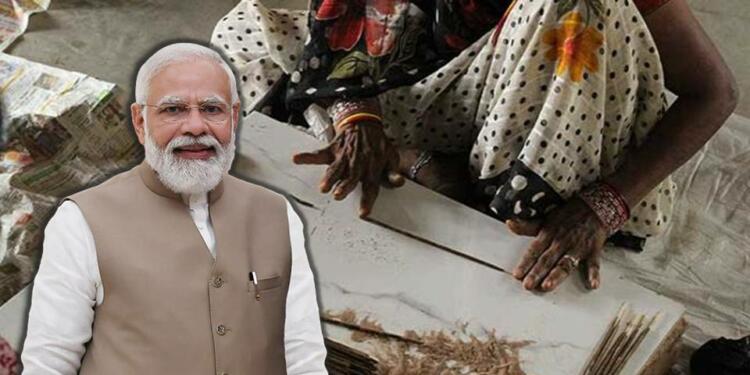India is a land of geniuses, with the capacity of turning historical difficulties into present-day opportunities. One such intellect is Prime Minister Narendra Modi, who is hell-bent on transforming India in every minute sphere. From strengthening economic relations to boosting the intent of self-manufacturing, PM Modi is determined to shape a new India with more than enough capabilities to cater to its needs.
We at TFI have often been observed as the propagators of PM Modi. However, we often break the glasses of those believers, because, in reality, we are the propagators of facts. And any intellectual will agree to this, that facts never lie.
The world’s largest democratic country was not self-reliant from start; rather its incessant efforts have paved the way for its development. This is one such fact-based report on agarbatti manufacturing in India. Agarbatti is not just an economic opportunity, but it’s a sacred thing for the Indian population.
Background of agarbatti
The agarbattis have been around since the Vedic era. It is manufactured with an evergreen tree, called “agar”. The tree is found in the tropical region of India. To add to it, incense sticks or agarbatti include basic ingredients of bamboo sticks, paste (usually made of charcoal dust), and perfume ingredients.
Previously, the agarbatti market was dominated by foreign countries. Though India was a producer of this healing tool, 96 per cent of the total Indian requirement of 70,000 metric tonnes was supplied by countries like Vietnam and China, leading India to back-step in the production process. Both these countries insanely dominated the agarbatti market through their bulk supply of raw materials.
However, concentrating on contemporary times, it can be observed that India is the leading manufacturer of agarbattis. The democratic country has been persistently putting effort in making this industry flourish and contribute to India’s economic development.
PM Modi’s efforts for lighting up indigenous agarbatti
Under the guidance of Prime Minister Narendra Modi, India has been surging its every facet of economical development with tremendous growth. From crude oil to agarbatti production, India is continuously marking an upswing with the brain ideas of PM Modi to transform India into a self-reliant country.
With the flagship of PM Modi, India is currently among the world’s top agarbatti-producing countries. According to a report published in 2021, Tripura produces around 2,500 metric tonnes of bamboo sticks. It was also estimated that probably, in the next few years, the production would further increase to 12,000 metric tonnes.
Earlier, the subsequent Congress regimes had forced India to rely on importing Bamboo sticks due to its forced restrictions on cutting trees under the forest act. But, soon the Modi government removed bamboo from the list of trees and placed it under its correct category, that is, a grass. This aided in the commercialisation of bamboo sticks, which came as a great benefit for the Indian agarbatti industry.
Further, the government’s decision to increase import duty on bamboo sticks from 10 per cent to 25 per cent, in order to curb heavy imports, gave way to increased employment in the sector. This move by the PM Modi-led government further boosted the local industry by discouraging imports for the same.
Also Read: Chinese toys outta Indian market: Make in India alters the rules of the game
Government schemes that boosted agarbattis
The government is recurrently expanding its support to local artisans involved in agarbatti making as part of its varied schemes and programs aimed at making India self-reliant in manufacturing.
As per a report published in 2020, the MSME Ministry approved a program called “Khadi Agarbatti Atmanirbhar Mission”, which is concentrated on creating employment for the unemployed and migrant workers, in addition to supporting the local agarbatti industry. This government initiation also included the supply of machines, inputs, and raw materials for its making with the inclusion of subsidies under the scheme.
Another scheme is Gramodyog Vikas Yojana, which is also a component of the Khadi Agarbatti Atmanirbhar Mission. It aims at promoting and developing the village industries through common facilities, technological modernization, and training. Additionally, it was objected to increasing the production of agarbatti manufacturing and creating sustainable employment by providing training to the artisans.
Though traditionally, the industry had been growing at a mere 3.6 per cent of growth rate, it is now witnessing a surged double-digit growth. All credit goes to the north-eastern bamboo sticks and to the successful implementation of various government schemes.
In the context of these schemes, under the guidance of PM Modi, India has culminated in an immense level of economic growth from the incense sticks industry. As per the All India Agarbatti Manufacturers’ Association (AIAMA), by the end of the Fiscal Year 2021, exports were estimated to go up by 15 percent. Apart from this, according to 2019 data by Export Promotion Council for Handicrafts (EPCH), the export rates of India in this industry have spiked to worth about Rs. 450 crores to Europe.
To conclude, the vast swathe of governmental schemes and programs turned India from importing to exporting or self-reliant manufacturing hub of agarbattis. The production of this spiritual tool is apparently driving India towards prosperity.
Support TFI:
Support us to strengthen the ‘Right’ ideology of cultural nationalism by purchasing the best quality garments from TFI-STORE.COM





























